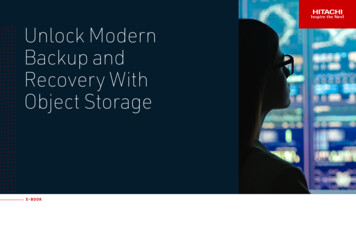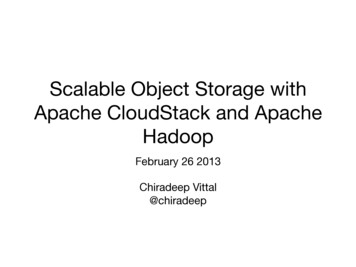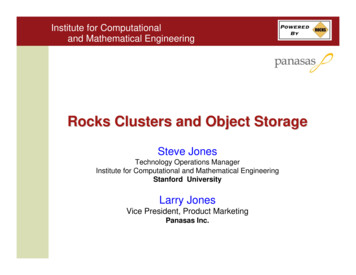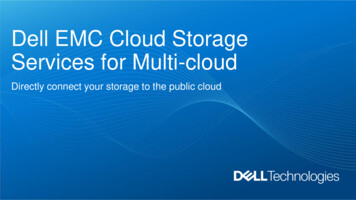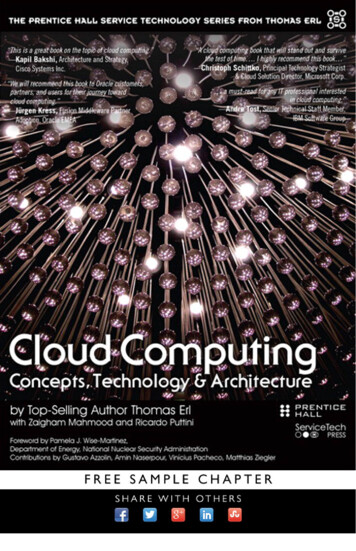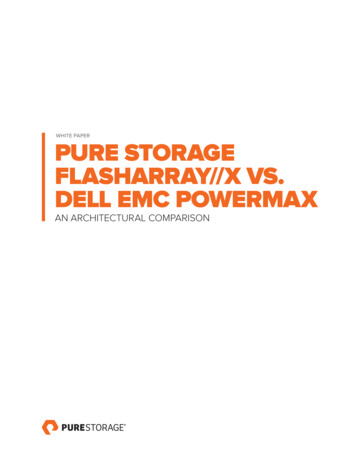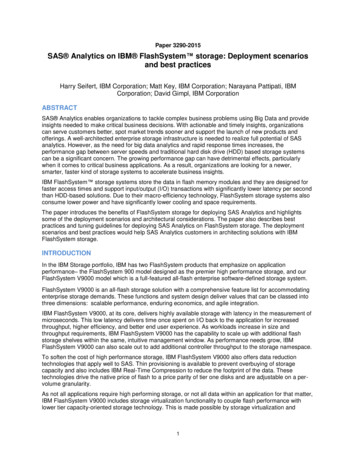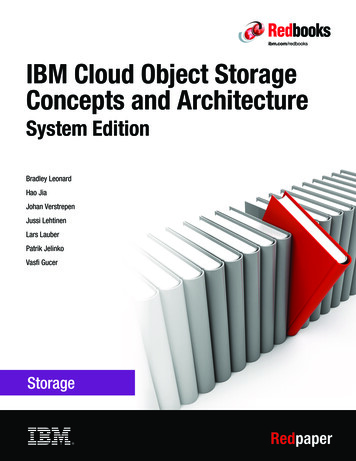
Transcription
Front coverIBM Cloud Object StorageConcepts and ArchitectureSystem EditionBradley LeonardHao JiaJohan VerstrepenJussi LehtinenLars LauberPatrik JelinkoVasfi GucerRedpaper
IntroductionObject Storage is the primary storage solution that is used in the cloud and on-premisessolutions as a central storage platform for unstructured data. Object Storage is growing morepopular for the following reasons: It is designed for exabyte scale. It is easy to manage and yet meets the growing demands of enterprises for a broad set ofapplications and workloads. It allows users to balance storage cost, location, and compliance control requirementsacross data sets and essential applications.IBM Cloud Object Storage (IBM COS) system provides industry-leading flexibility thatenables your organization to handle unpredictable but always changing needs of businessand evolving workloads.IBM COS system is a software-defined storage solution that is hardware aware. Thisawareness allows IBM COS to be an enterprise-grade storage solution that is highly availableand reliable and uses commodity x86 servers. IBM COS takes full advantage of this hardwareawareness by ensuring that the server performs optimally from a monitoring, management,and performance perspective.The target audience for this IBM Redpaper publication is IBM COS architects, IT specialists,and technologists.Summary of changes in this new revision (REDP5537-01):This paper is the new edition of the paper IBM Cloud Object Storage Concepts andArchitecture, REDP5537-00, that was originally published on May 29, 2019. The followingnew information is included in this revision: Retention enabled bucketsZone Slice Storage (ZSS)Performance improvements for SecureSlice EncryptionA table on advantages and disadvantages of the mirror modesHard synchronous option in mirror write threshold functionalityContainer and vault mode comparison tableData security enhancementsObject expirationIBM COS includes a rich set of features to match various use cases. Figure 1 on page 2shows IBM COS main features and typical use cases. Copyright IBM Corp. 2020. All rights reserved.ibm.com/redbooks1
Figure 1 IBM COS main features and typical use casesIBM validated more than 80 IBM and third-party applications with IBM COS and createdextensive technical documents that describe their interoperability.Validated applications per use case included the following examples: Backup:––––––IBM Spectrum Protect, IBM Spectrum Protect PlusCommvaultVeritas NetBackupRubrikVeeamActifio Active archive:– Komprise– Veritas Enterprise Vault– Moonwalk Enterprise file services:––––IBM Aspera CteraNasuniPanzura Enterprise content management:– IBM Filenet– IBM Content Manager On Demand Other:– IBM Spectrum Scale– Apache Spark2IBM Cloud Object Storage Concepts and Architecture: System Edition
– Merge Healthcare – Splunk– NiceTip: Most applications that support S3 API can use IBM COS for storage.For more information, see the IBM Cloud Object Storage web page.Differences between block, file, and Object StorageThe main difference between block, file, and Object Storage is who accesses the data: Block storageBlock storage is visible to operating systems or hypervisors that are running on a baremetal server. Operating systems write blocks of data on to disk tracks and sectors. File storageFile storage is often visible directly to users in the form of a directory by way of SMB orNFS storage protocol. Users must decide and know where to store files and rememberwhere to find them. Object StorageObject Storage is accessed directly from applications by way of RESTful API. An object isstored in a flat namespace with all other objects in the same namespace. An object nameis used to write and read objects from Object Storage.Object Storage provides the capability to add custom metadata to application data.Figure 2 shows the differences between block, file, and Object Storage.Figure 2 Differences between block, file, and Object Storage3
Use cases for Object StorageTypical application use cases for IBM COS across industries include the following examples: Analytics, artificial intelligence, and machine learning data repository; for example,Hadoop and Spark data lakes. IoT data repository; for example, Sensor data collection for autonomous driving. Secondary storage; for example:– Active archive: Tiering of inactive data from primary NAS filers.– Storage for backup data: Leading backup applications have native integration withObject Storage for longer term retention purposes. Storage for cloud native applications: Object Storage is the de-facto standard for cloudnative applications. Storing data in tabular parquet format: Provides significant data compression and allowsquery operations against the data.Industry-specific use cases for IBM COS include the following examples: Healthcare and Life Sciences:– Medical imaging, such as picture archiving and communication system (PACS) andmagnetic resonance imaging (MRI)– Genomics research data– Health Insurance Portability and Accountability Act (HIPAA) of 1996 regulated data Media and entertainment; for example, audio and video Financial services; for example, regulated data that requires long-term retention orimmutabilityFor information about use cases, see IBM Cloud Object Storage System Product Guide,SG24-8439.Flexible deployment options of IBM Cloud Object StorageIBM COS is available in the following modes: On-premises Object Storage:– IBM hardware appliances with IBM COS software– IBM certified third-party x86 servers with IBM COS software Public cloud Object Storage (multi-tenant)Figure 3 on page 5 shows the various deployment options for IBM COS.4IBM Cloud Object Storage Concepts and Architecture: System Edition
Figure 3 IBM COS deployment optionsNote: IBM COS Software is available in several licensing models, including perpetual,subscription, or consumption.This IBM Redpaper publication explains the architecture of IBM Cloud Object Storageon-premises offering and the technology behind the product. For more information aboutthe IBM Cloud Object Storage use case scenarios and deployment options, see IBM CloudObject Storage System Product Guide, SG24-8439.For more information about the IBM Cloud Object Storage public cloud offering, see thefollowing publications: Cloud Object Storage as a Service: IBM Cloud Object Storage from Theory to Practice,SG24-8385 How to Use IBM Cloud Object Storage When Building and Operating Cloud NativeApplications, REDP-5491IBM Cloud Object Storage architectureIBM COS is a dispersed storage system that uses several storage nodes to store pieces ofthe data across the available nodes. IBM COS uses an Information Dispersal Algorithm (IDA)to break objects into encoded and encrypted slices that are then distributed to the storagenodes.5
No single node has all of the data. This configuration makes it safe and less susceptible todata breaches while needing only a subset of the storage nodes to be available to retrieve thestored data. This ability to reassemble all the data from a subset of the slices dramaticallyincreases the tolerance to node and disk failures.The IBM COS architecture is composed of the following functional components. Each ofthese components runs IBM COS software that can be deployed on certified, industrystandard hardware: IBM Cloud Object Storage ManagerIBM Cloud Object Storage Manager provides a management interface that is used foradministrative tasks, such as system configuration, storage provisioning, and monitoringthe health and performance of the system.The Manager can be deployed as a physical appliance, VMware virtual machine, orDocker container. IBM Cloud Object Storage Accesser nodeIBM Cloud Object Storage Accesser node encrypts and encodes data on write anddecodes and decrypts it on read. It is a stateless component that presents the storageinterfaces to the client applications and transforms data by using an IDA.The Accesser node can be deployed as a physical appliance, VMware virtual machine,Docker container, or can run as an embedded Accesser node on the IBM Slicestor appliance. IBM Cloud Object Storage Slicestor nodeThe IBM Cloud Object Storage Slicestor node is responsible for storing the data slices. Itreceives data from the Accesser node on write and returns data to the Accesser node asrequired by reads. The Slicestor also ensures the integrity of the saved data and rebuilds ifnecessary.Slicestor nodes are deployed as physical appliances.Figure 4 shows a simple architecture layout of the different components in IBM COS.Figure 4 IBM Cloud Object Storage architecture6IBM Cloud Object Storage Concepts and Architecture: System Edition
S3 interface: IBM COS uses the S3 interface for all storage operations; for example: PUT: Writes an object to the storage.GET: Reads an object from the storage.DELETE: Deletes an object from storage.LIST: Lists objects that are in a bucket.All API calls are issued against an IBM COS Accesser node.Core conceptsThis section provides information about IBM COS core concepts. Figure 5 shows the majorIBM COS logical concepts.Figure 5 IBM Cloud Object Storage logical conceptsDevice setsIBM COS uses the concept of device sets to group Slicestor devices (see Figure 6 on page 8).Each device set consists of several Slicestor devices.7
Figure 6 Device set: A set of Slicestor devicesDevice sets can be spread across one or multiple data centers. All Slicestor nodes in onedevice set must have the same configuration (Slicestor node model, number of drives, anddrive size).Storage poolsA storage pool consists of one or more device sets that can be spread across multiple datacenters, as shown in Figure 7.Figure 7 IBM Cloud Object Storage storage poolsDevice sets in a storage pool can have different configurations. This configuration enablesadding newer Slicestor nodes to a system without replacing older Slicestor nodes.Note: Storage pool expansion must follow specific rules. For more information, see IBMCloud Object Storage System Product Guide, SG24-8439.8IBM Cloud Object Storage Concepts and Architecture: System Edition
VaultsVaults are logical storage containers for data objects that are contained in a storage pool, asshown in Figure 8.Important: A vault in IBM COS features the same functionality as an S3 bucket.Figure 8 IBM Cloud Object Storage vaultVaults are deployed on a storage pool and automatically spread across all the device sets.One or more vaults can be deployed to a storage pool.Mirrored vaultsA vault that is on one storage pool can be mirrored to a vault on another storage pool,commonly in a different location. Both component vaults are controlled by a mirror andstorage operations are issued against the mirror. All objects in the mirror are available on bothvaults. This concept is usually seen in a two site deployment, but can be used for other usecases, such as hub and spoke design.Recommended practice: Although vaults in a mirrored configuration can have differentIDAs and protection settings, it is recommended to have the same usable capacity on bothstorage pools in a two site configuration.A mirrored setup across two different sites protects the IBM COS system against a sitefailure. If one site is unavailable, reads and writes occur from the available vault automatically.A failover procedure is not required if the application can reach a functioning Accesser nodeat either site. A failback procedure is not required when the site comes back online.Access poolsAn access pool consists of one or more Accesser nodes, which present a vault to anapplication. More than one access pool can separate traffic or restrict access to certainvaults. This way, a tenant separation can be implemented.9
The connection between access pools and vaults is a many-to-many connection. One vaultcan be deployed on many access pools and one access pool can have more than one vaultdeployed.Information Dispersal AlgorithmThe Information Dispersal Algorithm (IDA) is based on erasure coding and defines thereliability, availability, and storage efficiency of an IBM COS system. The IDA is defined at thevault level at the vault creation time. The IDA is written as width/read threshold/writethreshold; for example: 12/6/8.The IDA consists of the following components: Width: The width of the IDA is the total number of slices that is generated by erasurecoding. For example, in a 12-wide storage pool all data has 12 slices. Read threshold: The read threshold of an IDA defines the number of slices of the widththat must be available for the data to be readable. For example, if the read threshold of a12-wide system is set to 6, the system needs only six slices to read the data.Tip: If the read threshold is set higher, the IBM COS system can survive fewer failures,but the storage efficiency is better. Write threshold: The write threshold of an IDA is the number of slices of the width thatneed to be written before the Accesser node returns the success to the client. The writethreshold always must be higher than the read threshold so that the data is available, evenif a failure occurs right after the write is completed. For example, if the write threshold ofa 12-wide system is set to 8, the system musty successfully write eight slices to completea write request.Tip: If the write threshold is set lower, the IBM COS system can survive more failures,but the storage efficiency suffers because of the higher redundancies.Expansion factor: The expansion factor is calculated as the width divided by the readthreshold. It also defines the ratio of raw capacity versus usable capacity. See Table 1 onpage 12 for examples.Dispersal modesIBM COS can operate in two different dispersal modes, as shown in Figure 9.Figure 9 Dispersal modes in IBM COS10IBM Cloud Object Storage Concepts and Architecture: System Edition
In Standard Dispersal Mode (SD Mode), which is also called non-Concentrated DispersalMode,
29.05.2019 · – Veritas NetBackup –Rubrik – Veeam – Actifio Active archive: – Komprise – Veritas Enterprise Vault – Moonwalk Enterprise file services: – IBM Aspera –Ctera – Nasuni –Panzura Enterprise content management: – IBM Filenet – IBM Content Manager On Demand Other: – IBM Spectrum Scale – Apache Spark. 3 – Merge Healthcare –Splunk – Nice For more information .

